The hua qian coin [花錢], also known as ya sheng qian [壓勝錢], hua qian [畫錢], and min su qian [民俗錢], is not a circulating coin with monetary function. Such coins feature folkloric patterns or characters to express some wishes and purposes, which reflects the culture, thoughts, and concepts of the society at that time.
The hua qian coin is believed by academics to have originated in the Han dynasty and began to flourish during the Wendi Emperor and Wudi Emperor’s reign. The early hua qian coin looks almost identical to the coin in circulation at that time in terms of shape and the inscription, except that characteristic patterns and symbols have been added. Similar to the half tael hua qian coins, most of the characters on the hua qian coins are cast differently according to the time and place, and there is no fixed pattern. For example, xiang si [相思], shang wen [上問], tai chang [太常], ru yan [如言], yi [易], chang shou [長壽], hu yu gong [胡羽公], chang xiang si [長相思], chang wu xiang wang [長毋相忘], chang fu gui le wei yang [长富贵 乐未央] and many other characters are inscribed on the hua qian coins. (Fig.1) Subsequently, the hua qian coin cast for a certain purpose arose. For instance, some coins are inscribed with ri ru qian jin chang wu xian wang [日入千金 長毋相忘, which means that if you become rich and honored one day, don't forget me] (Fig. 2) and pi bing mo dang qu xiong chu xiang [兵 莫當去凶除央, which means to dispel the evil and the disease]. Also, their shape was changed to be more wearable with a hole at the top and bottom, or with hollowed flower, star or moon patterns. Some large half tael hua qian coins in the Wendi Emperor and Wudi Emperor’s reign are inscribed with chang fu gui le wei yang, which means to have long-time prosperity and happiness. Some coins also have incised and raised figures. As for those cast in the Qin and Hand dynasties, some features the stars, fishes, birds or beasts, while some feature flowers and columns. There is a half tael coin of 3-4 millimeters in diameterunearthed from the mausoleum of the Jingdi Emperor, which is an officially cast hua qian coin whose inscription is even more delicate than circulating coins.
The hua qian coin is believed by academics to have originated in the Han dynasty and began to flourish during the Wendi Emperor and Wudi Emperor’s reign. The early hua qian coin looks almost identical to the coin in circulation at that time in terms of shape and the inscription, except that characteristic patterns and symbols have been added. Similar to the half tael hua qian coins, most of the characters on the hua qian coins are cast differently according to the time and place, and there is no fixed pattern. For example, xiang si [相思], shang wen [上問], tai chang [太常], ru yan [如言], yi [易], chang shou [長壽], hu yu gong [胡羽公], chang xiang si [長相思], chang wu xiang wang [長毋相忘], chang fu gui le wei yang [长富贵 乐未央] and many other characters are inscribed on the hua qian coins. (Fig.1) Subsequently, the hua qian coin cast for a certain purpose arose. For instance, some coins are inscribed with ri ru qian jin chang wu xian wang [日入千金 長毋相忘, which means that if you become rich and honored one day, don't forget me] (Fig. 2) and pi bing mo dang qu xiong chu xiang [兵 莫當去凶除央, which means to dispel the evil and the disease]. Also, their shape was changed to be more wearable with a hole at the top and bottom, or with hollowed flower, star or moon patterns. Some large half tael hua qian coins in the Wendi Emperor and Wudi Emperor’s reign are inscribed with chang fu gui le wei yang, which means to have long-time prosperity and happiness. Some coins also have incised and raised figures. As for those cast in the Qin and Hand dynasties, some features the stars, fishes, birds or beasts, while some feature flowers and columns. There is a half tael coin of 3-4 millimeters in diameterunearthed from the mausoleum of the Jingdi Emperor, which is an officially cast hua qian coin whose inscription is even more delicate than circulating coins.
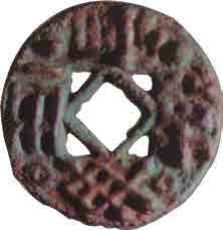
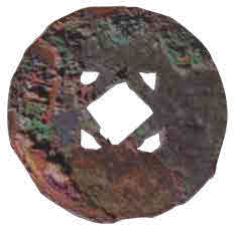
Fig. 1 Half tael ya sheng coin inscribed with chang wu of the Western Han dynasty from Song Jie's collection. (From The Collection of Coins and Selected Writings by Students of Mr. Dai Baoting)

Fig. 2 Ya sheng coin inscribed with chang wu xiang wang ri ru qian jin of the Han dynasty(From Beijing Hanhai Autumn Auction 2011 Catalogue)
The wu zhu [五銖] coin was mainly cast for praying for blessings to avoid evil spirits, but it is much more diverse in inscriptions and patterns. The auspicious inscriptions include jun yi hou wang [ 君宜侯王 ], da yi zi sun [大宜子孫], chang le wei yang [長樂未央], qian wan quan [千萬泉], yi guan zhi ji [宜官秩吉], ji [吉], pi bing yi zi [辟兵宜子], and da li yi zi sun [大利宜子孫]. Most of these inscriptions are engraved on the mould, with few customized patterns and inscriptions. The patterns are mainly Queen Mother of the West, attendants, fish, sacred animals, ringheaded swords, hooks, and constellations. In the early Eastern Han dynasty, coins with constellation patterns accounted for the majority of the wu zhu coins. In terms of such coins, their obverses are inscribed with constellation-related characters such as pi bing [辟兵] and yi zi [宜子], and some are inscribed with the name such as gong sun xian [公孫閑]. The constellation patterns are divided into several types, such as the five stars, three stars of fortune, prosperity, and longevity, and four stars of orientation (which can also be represented by green dragon, white tiger, red bird, and black tortoise), and the seven stars of the Big Dipper. There are also animal patterns such as dragon, tiger, crane, fish, bird, and dog. In addition, some coins feature four dragons on the upper, lower, left, and right, and all dragons are moving toward the left. Besides, some tools are used as the patterns, such as hooks and ringheaded knives. Thereare also some coins featuring ornamental patterns like characters jue [決], chu [出], jing [井], and wan [萬], compasses, rulers, beads, and auspicious clouds. As for incised and raised figures, they are not found in the wu zhu coins in the Western Han dynasty, but they came to be popular among the wu zhu coins in the middle and late Eastern Han dynasty.
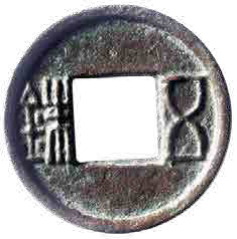
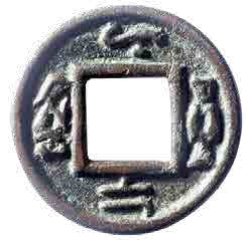
Fig.3 Wu zhu coin of the Han dynasty with attendants and TL patterns
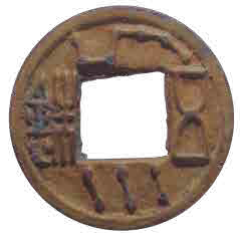
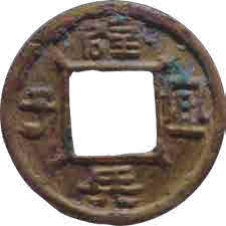
Fig. 4 Gilt wu zhu coin inscribed with pi bing yi zi of the Eastern Han dynasty from Song Jie's collectin (From The Collection of Coins and Selected Writings by Students of Mr. Dai Baoting)
Given the shape and pattern of the hua qian coin of the Western Han period, it underwent a decline for a period of time due to political and economic changes at the end of the Western Han period. When it came to Wang Mang's reign, the hua qian coin began to rise again, and its inscription and pattern had new content. The inscription on the da quan wu shi [大泉五十] hua qian coins can be divided into two types. One is praying for good fortune, such as chang le wei yang [長樂未央], da yi zi sun [大宜子孫], chang yi zi sun [長宜子孫], ri ru zi kang [日入子康], chang bao zi sun [長葆子孫], yi jun zi sun [宜君子孫], yi zi sun fu gui chang le wei yang da ji yang ming yi chang [宜子孫 富貴昌 樂未央 大吉羊 命益長], pi bing wang quan [辟兵王泉], and yi zi sun yi guan zhi [宜子孫官秩]. The other one is to pray for wealth, such as yi quan [宜泉], ri li [日利], qian wan quan [千萬泉], da li qian wan [大利千萬], da li bai wan nian [大利百萬年], da li yi quan [大利宜泉], yi quan wan bei [宜泉萬倍], wan bei ju wan [萬倍巨萬], da li ba qian wan [大利八千萬], etc. Patterns are divided into astronomical patterns such as compasses, the moon with a star, four stars of orientation, etc.; tools such as hooks, swords, etc.; animals such as dragons, horses, deer, fish, etc.; ornamental patterns such as curving lines and zigzagging grids. Auspicious inscriptions, constellations, and animals are all characteristic patterns of the hua qian coin. There are many variations of the auspicious inscription and patterns. Those coins with mythical figures of si ling [四靈], wang mu [王母], fang xiang [方相], and yu ren [羽人] from the myths of the Eastern Han dynasty are assumed to be cast in the Eastern Han dynasty. The main change in the middle and late Han Dynasty is the emergence of money trees. The coins on the tree saw some changes in the inscriptions such as wu li hou [五利後] and wu wu [五五].
The hua qian coin of the Han dynasty imitated the shape of the half tael and wu zhu coins at the beginning, just with some simple patterns and auspicious inscriptions added. Then, its pattern and inscription came to be more diverse and elegant, which reflected the spiritual needs of various social classes and the belief in the gods of the universe. Therefore, the style of the hua qian coin developed to give birth to a corresponding culture with rich folklore and spiritual connotations. The investigation of the origin of the hua qian coin and the interpretation of its patterns and inscriptions enable us to understand the beliefs, religion, cosmology, the expectation of a peaceful life and a long healthy life of the ancients from the perspective of the characteristic culture of the hua qian coin. The deep connotation behind its origin also has a profound influence on the development of the hua qian coin in later years
